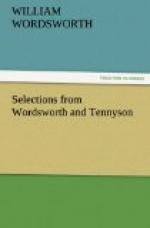TO THE DAISY
COMPOSED 1802: PUBLISHED 1807
“This and the other poems addressed to the same flower were composed at Town-end, Grasmere, during the earlier part of my residence there.” The three poems on the Daisy were the outpourings of one mood, and were prompted by the same spirit which moved him to write his poems of humble life. The sheltered garden flowers have less attraction for him than the common blossoms by the wayside. In their unobtrusive humility these “unassuming Common-places of Nature” might be regarded, as the poet says, “as administering both to moral and spiritual purposes.” The “Lesser Celandine,” buffeted by the storm, affords him, on another occasion, a symbol of meek endurance.
Shelley and Keats have many beautiful references to flowers in their poetry. Keats has merely a sensuous delight in their beauty, while Shelley both revels in their hues and fragrance, and sees in them a symbol of transitory loveliness. His Sensitive Plant shows his exquisite sympathy for flower life.
TO THE CUCKOO
COMPOSED IN THE ORCHARD AT TOWN-END 1802: PUBLISHED 1807
Wordsworth, in his Preface to the 1815 edition, has the following note on ll. 3, 4 of the poem:—“This concise interrogation characterises the seeming ubiquity of the cuckoo, and dispossesses the creature almost of corporeal existence; the Imagination being tempted to this exertion of her power, by a consciousness in the memory that the cuckoo is almost perpetually heard throughout the season of spring, but seldom becomes an object of sight.” The cuckoo is the bird we associate with the name of the vale of sunshine and of flowers, and yet its wandering voice brings back to him the thought of his vanished childhood. We have already noticed the almost sacred value which Wordsworth attaches to the impressions of his youth, and even to the memory of these impressions which remains with him to console his maturer life. The bird is a link which binds him to his childhood:
“And I can listen to thee yet;
Can lie upon the plain
And listen, till I do beget
That golden time again.”
In other poems, especially in the Intimaticns of Immortality, he speaks of “the glory and the freshness of a dream,” which hallowed nature for him as a child, and which grew fainter as the “shades of the prison-house began to close upon the growing Boy”.




